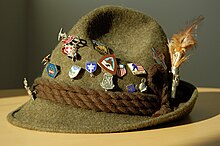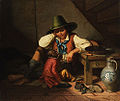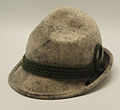Tyrolean hat


The Tyrolean hat (
Description
A typical Tyrolean hat is made of green
In addition to varying in shape and width of brim, the hats are characteristically decorated with a coloured, corded
History
In the 19th and 20th centuries, Tyrolean costumes developed a certain degree of uniformity in their appearance. In the local village costumes of the Tyrol, the various styles of Tyrolean hat have survived since the 1830s/1840s, albeit similar to those of contemporary fashion. These original forms vary from the tall, relatively narrow-brimmed hats of North Tyrol which were dented on top, to the small, wide-brimmed hats of the South Tyrolean wine country.
Later the Tyrolean hat became the image bearer of "Tyrolean culture" as a tourist symbol, very popular at folk gatherings and beer festivals, such as the Munich Oktoberfest, and influenced by folk music bands who wore fanciful "local" costumes. The musician, Billy Mo, wrote a song in 1962 called "Ich kauf' mir lieber einen Tirolerhut" ("I Prefer to Buy a Tyrolean Hat"), which reinforced the link between the hat and traditional Alpine (brass band) folk music. In 1965, a comedy musical appeared under the same title.[4]
The Tyrolean hat became even better known thanks to
Gallery
-
Boy with Tyrolean hat and monkey (Knabe mit Tirolerhut und Äffchen). Oil on canvas, c. 1834
-
Andreas Hofer, wearing the typical, broad-brimmed flat hat of the South Tyrolean type (posthumous portrait, mid-19th century)
-
Self portrait with Tyrolean hat (Selbstporträt mit Tiroler Hut), Lovis Corinth
-
Simple, party version of the Tyrolean hat
-
Grey variant of the Tyrolean hat
See also
- Campaign hat
- Seppel, the figure with a Seppelhut hat, the Bavarian-North Tyrolean felt cap with or without a brim
References
- ^ "[T]he pointed, green, felt hat with a hand-wide brim, which came from South Tyrol, especially from the Ziller valley, earned such a reputation that it was referred to as a Tyrolean hat." Heinrich Heine: Reisebilder II: 1828-1831: Kommentar, Volume 6. Akademie Verlag, 2003, p. 232 (N.B.: the Ziller valley lies in North Tyrol)
- ^ [1] Genuine Gamsbart $2,790.00, Ernst Licht Imports, May 27, 2021
- ^ Kilgour, Ruth Edwards (1958). A Pageant of Hats Ancient and Modern. R. M. McBride Company.
- ^ Ich kauf mir lieber einen Tirolerhut. Moviepilot.de
- ^ Lexikon der Herrenmode, Musterschmidt, 1960
- ISBN 978-87-76-95362-1.
- ISBN 978-1-61069-063-8.





